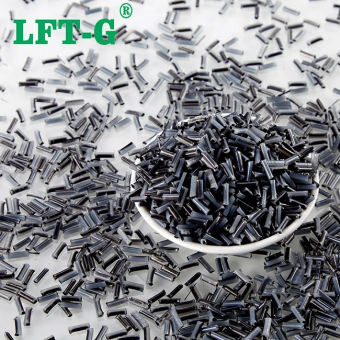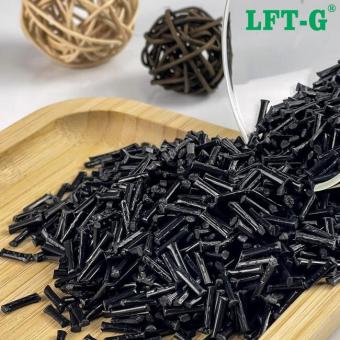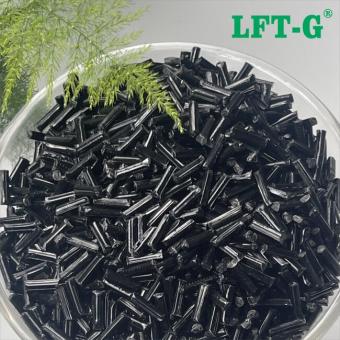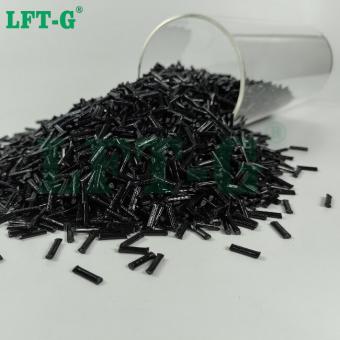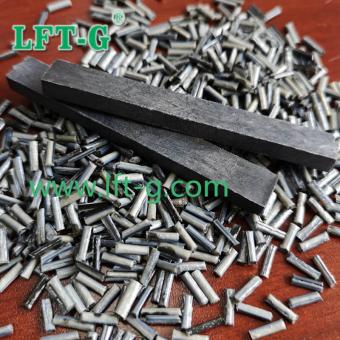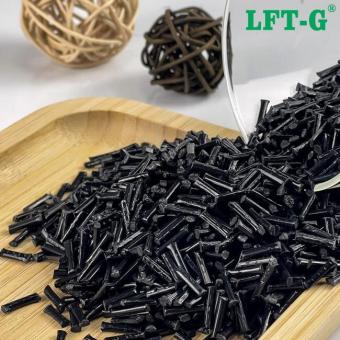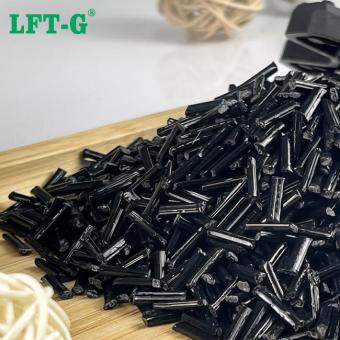La fibre de carbone longue est un nouveau matériau offrant une résistance élevée, un module élevé et d'excellentes propriétés mécaniques. c'est un matériau en graphite microcristallin obtenu par carbonisation et graphitisation de fibres organiques. sa densité est inférieure à 1/4 de l'acier et sa résistance est supérieure à celle de l'acier. résistant à la corrosion, haut module, pas de fusion. et une variété de substrats de résine après moulage par extrusion d'imprégnation en pellets, polymère de fibres de carbone longues. peut être utilisé pour les produits de moulage direct. ces dernières années, il a été largement utilisé dans les domaines de la chimie aérospatiale, mécanique et électronique.
-
Chine Fabricant PEEK Résine Longue Granulés Renforcés De Fibres De CarboneLe PEEK pur lui-même est un plastique technique spécial, doté d'une résistance aux radiations, d'une autolubrification, d'une résistance aux températures élevées, d'une résistance à l'usure, d'une résistance à la fatigue et d'autres caractéristiques. Les performances du matériau PEEK renforcé de fibres de carbone se sont améliorées à bien des égards par rapport au matériau PEEK pur. Le matériau composite renforcé de fibres de carbone longues PEEK est 5 fois plus résistant que le métal, 60 % plus léger et plus de 10 % meilleur que les produits similaires. .
- Fournisseur de matériaux PEEK
- plastique polymère thermoplastique PEEK
- Usine vend du polyéther éther cétone
- Granulés remplis de carbone PEEK
- Moulage par injection couleur noire
- Propriétés du PEEK haute résistance
Tags :
-
Composés longs renforcés de fibres de carbone LFT Nylon Polyamide 12Le matériau renforcé de fibres de carbone longues PA12 combine les excellentes propriétés du polyamide 12 avec la résistance et la rigidité des fibres de carbone longues. Ce composite haute performance offre une résistance mécanique supérieure, une résistance aux chocs et une stabilité dimensionnelle, ce qui le rend idéal pour les applications exigeantes dans les secteurs de l'automobile, de l'aérospatiale et de l'industrie.
- Fournisseur de fibres de carbone longues PA12
- Impression 3D composite PA12 automobile
- Résine thermoplastique fabriquée en Chine
- Granulés de résine polymère à filament pA66
- EDM en gros sur stock matériaux PA 12
- Meilleur prix PA12 haute résistance
Tags :
-
Composés longs renforcés de fibres de carbone LFT Nylon Polyamide 66Le PA66-CF40 est un PA 66 renforcé à 40 % de fibres de carbone longues, offrant une résistance, une résistance au fluage, une rigidité et une stabilité dimensionnelle exceptionnelles. Après modification, le PA66-CF40 présente des propriétés mécaniques exceptionnelles, ce qui le rend très résilient et idéal pour les applications à charge élevée dans des environnements à températures extrêmes. Ce matériau est particulièrement adapté aux composants qui nécessitent une résistance et une durabilité élevées sur des périodes prolongées, tels que les capots et les pièces structurelles des machines et des véhicules.
- PA66 Mastic PA CFRP 40 30 20
- application polymaker pa66-cf30
- EDM en gros sur stock matériaux PA 66
- Meilleur prix PA66 haute résistance
Tags :
-
Nylon Polyamide 6 remplissant de longs composés renforcés de fibres de carboneLes composites à fibres de carbone longues PA6 offrent une résistance, une rigidité et un faible poids exceptionnels, ce qui les rend idéaux pour les applications hautes performances dans des secteurs tels que l'automobile, l'aérospatiale et l'électronique. Ces matériaux offrent des propriétés mécaniques supérieures, notamment une résistance élevée à la traction et une excellente résistance à la fatigue, tout en garantissant également une stabilité dimensionnelle améliorée dans des conditions extrêmes. Les composites à fibres de carbone longues PA6 constituent une solution fiable pour remplacer les métaux dans les composants structurels légers et exigeants.
- PA6 Mastic PA CFRP 40 30
- application polymaker pa6-cf30
- Filament en fibre de carbone pA6
- EDM en gros sur les matériaux PA6 en stock
- Meilleur prix PA6 haute résistance
Tags :
-
Polymère de remplissage en polypropylène homopolymère longue fibre de carbone pour l'automobileLes composites à fibres de carbone longues homopolymère PP offrent d'excellentes propriétés mécaniques, notamment une résistance, une rigidité et une résistance aux chocs élevées. Ces matériaux sont idéaux pour les applications hautes performances dans les secteurs automobile, aérospatial et industriel, où des solutions légères mais durables sont essentielles. Avec une stabilité dimensionnelle et une résistance thermique supérieures, les composites à fibres de carbone longues homopolymère PP offrent une alternative fiable aux métaux dans les environnements exigeants.
- Fibre de carbone pp haute ténacité
- Résine de polypropylène fabrication chinoise
- Filament en fibre de carbone pp CF CFRP
- EDM en gros sur les matériaux PP en stock
- Meilleur prix PP haute résistance
Tags :
-
Fibre de carbone longue de polypropylène de copolymère de très haute résistance remplieLe polypropylène (PP) renforcé de fibres de carbone longues copolymères combine les avantages des fibres de carbone longues et la flexibilité des copolymères PP, offrant une résistance, une rigidité et une résistance aux chocs exceptionnelles. Il est idéal pour les applications exigeantes dans des secteurs tels que l'automobile, l'électronique et l'aérospatiale, où des performances mécaniques élevées et un faible poids sont essentiels. Ce matériau offre une stabilité dimensionnelle supérieure, une résistance à la chaleur et une résistance améliorée à la fatigue et à l'usure.
- fibre de carbone pp
- CFRP recyclé Léger au lieu de métal
- pp renforcé de fibre de carbone
- pièces imprimées en 3D en fibre de carbone
- Meilleur prix PP haute résistance
Tags :
-
Composite PEEK renforcé de fibre de carbone ultra résistant – Matériau d'ingénierie haute performanceLes matériaux composites PEEK renforcés de fibres de carbone combinent les propriétés de haute performance du PEEK avec la résistance et la durabilité de la fibre de carbone, ce qui les rend idéaux pour les applications dans des environnements extrêmes et pour l'impression 3D.
- Plastique haute température
- Matériaux composites PEEK
- PEEK renforcé de fibre de carbone
- Plastiques haute performance
- COUP D'ŒIL D'IMPRESSION 3D
- Applications des matériaux PEEK
Tags :
-
Polypropylène homopolymère (PP) renforcé de fibres de carbone longues de qualité supérieure LFT-G™ pour les applications hautes performancesNotre Fibre de carbone longue PP est un composite de polypropylène haute performance, conçu pour une résistance exceptionnelle et des propriétés de légèreté, ce qui le rend idéal pour les applications exigeantes telles que les pièces automobiles.
- Matériaux composites PP
- Fibre de carbone PP pour l'automobile
- Plastique léger en fibre de carbone
- Longue fibre de carbone PP
- Polypropylène renforcé de fibre de carbone
- Polypropylène haute performance
Tags :
-
Composite PEEK renforcé de fibre de carbone ultra résistant – Matériau d'ingénierie haute performanceLes matériaux composites PEEK renforcés de fibres de carbone combinent les propriétés de haute performance du PEEK avec la résistance et la durabilité de la fibre de carbone, ce qui les rend idéaux pour les applications dans des environnements extrêmes et pour l'impression 3D.Afficher plus
-
LFT Nylon Polyamide 12 Fabricant Composés remplis de fibre de carbone plastique technique spécialSi vous ne savez pas quel matériau de sonorisation vous convient, veuillez nous indiquer vos besoins et notre équipe vous fournira une assistance technique gratuite.
- Matériau renforcé de résine thermoplastique PA 12
- polymère de remplissage en fibres au lieu d'acier métallique
- Échantillon gratuit de plastique naturel nouveau CFRP
- pièces structurelles en plastique d'ingénierie
- résine modifiée bon prix bas MOQ
- ailes automobiles Résistant à l'usure Flexible
Tags :
-
Xiamen LFT-G Polyamide 66 longue résistance à l'usure remplie de fibres de carbone pour les pièces automobilesPropriétés physiques des matériaux en nylon Excellentes propriétés mécaniques : haute résistance mécanique, bonne ténacité. Excellent auto-mouillage, résistance à l'usure : faible coefficient de frottement, longue durée de vie en tant que composant de transmission. Excellente résistance à la chaleur : la température de distorsion thermique du PA66 est très élevée, peut être utilisée pendant une longue période à 150 degrés Celsius, le PA66 après renforcement de la fibre de verre, la température de distorsion thermique de 252 degrés Celsius ou plus. Excellentes propriétés d'isolation électrique : sa résistance volumique est très élevée, sa résistance élevée à la tension de claquage est un excellent matériau d'isolation électrique/électronique. Présentation des pellets LCF chargés en Nylon66 Le PA66 est un plastique technique de haute performance, absorbant l'humidité, mauvaise stabilité dimensionnelle des produits, résistance et dureté du métal. Afin de surmonter ces inconvénients, dès les années 1970, les gens ont utilisé la fibre de carbone et la fibre de verre pour améliorer ses performances. PA66 renforcé avec des matériaux en fibre de carbone ces dernières années, le développement a été plus rapide, car le PA66 et la fibre de carbone sont d'excellentes performances dans le domaine des matières plastiques techniques, le matériau composite incarnation complète de la supériorité des deux, comme la résistance et la rigidité que le PA66 non amélioré est beaucoup plus élevée que celle du fluage à haute température est faible, la stabilité thermique d'une amélioration significative de la précision dimensionnelle du bon, résistant à l'usure. À l'heure actuelle, les matériaux composites en fibre de carbone PA66 sont principalement des particules renforcées de fibres de carbone courtes ou longues et ont été largement utilisés dans l'industrie automobile, les articles de sport, les machines textiles, les matériaux aérospatiaux et d'autres domaines. La fibre de carbone est légère, haute résistance à la traction, résistance à l'abrasion, résistance à la corrosion, résistance au fluage, conductivité électrique, transfert de chaleur, etc. Elle est très similaire à la fibre de verre, mais supérieure à la fibre de verre. Par rapport à la fibre de verre, le module est 3 fois plus élevé, qui est un matériau à haute rigidité et haute résistance. Fiche technique du PA6-LCF pour référence D'après les expériences du département technique, nous savons que la résistance à la flexion, le module d'élasticité à la flexion, la résistance aux chocs et la résistance au cisaillement plan du matériau à base de fibres PA66 en fibre de carbone augmentent avec l'augmentation de la teneur en fibres de carbone et de la résistance au cisaillement transversal. légèrement diminué, dans l'ensemble, la résistance du matériau a considérablement augmenté. Application du PA66-LCF Certificat Certification du système de gestion de la qualité ISO9001/16949 Certificat national d'accréditation de laboratoire Entreprise d'innovation en matière de plastiques modifiés Certificat honorifique Tests REACH et ROHS pour les métaux lourds Usine et laboratoire Questions et réponses 1. Existe-t-il des données de référence unifiées pour les performances des produits en fibre de carbone ? Les performances de filaments de fibre de carbone spécifiques sont fixes, comme les filaments de fibre de carbone de Toray, T300, T300J, T400, T700 et ainsi de suite, une série de paramètres peuvent être suivis. Cependant, il n’existe pas de norme uniforme pour mesurer les produits composites en fibre de carbone. Premièrement, les différents types de matières premières sélectionnées entraîneront des performances différentes des produits, puis en raison du choix de la matrice et de la conception différente des produits, cela entraînera des performances différentes des produits. En plus de certains tubes en fibre de carbone courants, panneaux en fibre de carbone et autres pièces conventionnelles, la plupart des produits en fibre de carbone dans la production de l'échantillon avant le test pour déterminer si les performances du produit sont conformes à l'utilisation de la norme attendue , et comme point de base, afin de réaliser la production et l'utilisation de grandes quantités. 2. Les produits composites en fibre de carbone sont-ils chers ? Le prix des produits composites en fibre de carbone est étroitement lié au prix des matières premières, au niveau de technologie et à la quantité de produits. Certains produits de l'environnement industriel ont des exigences élevées, la performance des produits et matériaux en fibre de carbone a des exigences particulières, ce qui nécessite la sélection de matières premières spécifiques, de matières premières, plus la performance du prix naturel du plus cher, comme le application de matériaux thermoplastiques orthopédiques PEEK en fibre de carbone. Bien entendu, plus le processus de production est complexe, plus le temps et la charge de travail s...
- Matières premières en plastique PA66 moulées par injection
- Granulés purs recyclés PA66 légers
- longue fibre de carbone pa66 couleur noir naturel
- Pa66 granulés lcf au lieu de polymères métalliques
- Appareil électronique à faible déformation
- pièces automobiles et pièces aérospatiales
Tags :

 email
email français
français English
English Deutsch
Deutsch русский
русский italiano
italiano español
español português
português العربية
العربية 日本語
日本語 한국의
한국의 中文
中文













